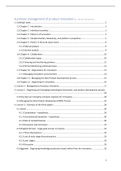Summary management of product innovation by Tobias Schiphorst
1. Schilling’s book .................................................................................................................................... 2
1.1 Chapter 1 : Introduction ................................................................................................................ 2
1.2 Chapter 2 : Individual creativity .................................................................................................... 2
1.3 Chapter 3 : Patterns of Innovation ................................................................................................ 2
1.4 Chapter 4 : Standard battles, Modularity, and platform competition .......................................... 5
1.5 Chapter 6 : Porter’s 5 forces & value chains ................................................................................. 6
1.5.1 External analysis ..................................................................................................................... 6
1.4.2 Internal analysis...................................................................................................................... 9
1.6 Chapter 8 : Collaboration ............................................................................................................ 10
1.6.1 Collaboration types .............................................................................................................. 10
1.6.2 Choosing and monitoring partners....................................................................................... 12
1.6.3 Partner Monitoring and Governance ................................................................................... 13
1.7 Chapter 10 : Organization for innovation.................................................................................... 13
1.7.1 Managing innovation across borders ................................................................................... 14
1.8 Chapter 11 : Managing the New Product Development process ................................................ 15
1.9 Chapter 12 : Organizing for innovation ....................................................................................... 16
2. Lecture 1 : Management of product innovation ............................................................................... 17
3. Lecture 2 : Organizing and managing technological innovation, new product development process
............................................................................................................................................................... 18
3.1 How does an innovative company organize for innovation ........................................................ 18
3.2 Managing the New Product Development (NPD) Process .......................................................... 22
4. Lecture 3 : Summary of the three papers ......................................................................................... 28
4.1 Jansen .......................................................................................................................................... 28
4.1.1 Coordination – hypotheses .................................................................................................. 29
4.1.2 Environmental dynamism – hypotheses .............................................................................. 30
4.1.3 Role of competitiveness ....................................................................................................... 30
4.1.4 Discussion and conclusion .................................................................................................... 31
4.2 Klingebiel & Esser : stage-gate process in practice ..................................................................... 32
4.2.1 Three observations: .............................................................................................................. 32
4.2.2 Lack of early stage discontinuations .................................................................................... 33
4.2.3 Later stages........................................................................................................................... 33
4.2.4 Discussion ............................................................................................................................. 33
4.3 Aggarwal : Organizing knowledge production teams within firms for innovation ..................... 33
1
,1. Schilling’s book
Summary of partly the lecture slides and the Schilling’s video’s supported by the book.
Topic Content
Introduction into - Highlight key aspects (chapters 1-4, 6, 8)
important concepts - Sources and types of technological innovation (chapters 2 & 3)
- Technology S-curves and dominant design (chapter 3 & 4)
- Technology strategy (chapter 6)
- R&D alliances (chapter 8)
Organizing and - Organizating for technological innovation (chapter 10)
managing - The new product development process (chapter 11)
technological - New product development teams (chapter 12)
innovation/ the new
product development
process
1.1 Chapter 1 : Introduction
Technological innovation -> the act of introducing a new device, method, or material for application
to commercial or practical objectives.
Impact of technological innovation -> increases the amount of output achievable from a given
quantity of labour and capital. But has negative externalities on the environment, pollution, erosion
and depletion of the earth.
1.2 Chapter 2 : Individual creativity
Individual creativity -> is a function of someone’s intellectual abilities, knowledge, personality,
motivation, and environment.
- Intellectual abilities: intelligence, memory, ability to look at problems in unconventional ways
o Intelligence: primary process thinking of combining unrelated ideas
o Memory: having lots of working memory is useful in searching for new ideas
- Knowledge: lots of knowledge can make you more familiar with potential solutions, but too
much knowledge can trap you in assumptions. (breakthrough innovation often comes from
outside the industry)
- Personality: wanting to have lots of autonomy will increase creativity or being open to
experiences.
- Motivation: intrinsic motivation or working on what you like increases creativity
- Environment: environment that lets people be individualistic, risk tolerant and empowering
increases creativity
1.3 Chapter 3 : Patterns of Innovation
S-curve in technology performance -> graph with on the x-axis the effort and on the y-axis the
performance.
2
,At the beginning improvement of technology is very difficult, but as you put in more effort over time
you will see faster improvements of technology until you get near to the limit of technology flatting
the curve again, as improvement becomes hard again.
- The steeper the S-curve the associated technology payoff is higher
- The higher the S-curve means that as time goes by the associated technology payoff is
higher, even when the steepness is less.
Discontinuous (disruptive) technology -> A technology that fulfils a similar market need by building
on an entirely new knowledge base (e.g. switching from an propellers to jets in order to fly)
- When discontinuous technology has an steeper or an increased S-curve than the current
technology, there may come an time that de returns of the discontinuous technology are
higher than the current technology.
Technology diffusion -> technology curves are also used to describe the spread of an technology
through an population.
- Initially slow and accelerates as the technology becomes better understood by the mass
market
- Technology diffusion takes much more time than information diffusion, people might already
know about the technology, but they don’t implement it because:
o The newer technology can be complex to understand at first
o The newer technology can be tacit requiring person to person contact
o Many newer technologies become valuable after an set of complementary resources
are developed for its users.
- As technology diffusion increases the more the newer technology is adopted, more adoption
of the newer technology means lower prices, which again attracts more new users.
S-curves as a prescriptive tool -> use data on investment (effort) and performance of your
technology to assess whether your technology appears to be approaching its limits.
Limitations of S-curve model as a prescriptive tool -> it is rare to know the limits of an technology in
advance and the shape of the technology s-curve are not fixed in the market. So you don’t really
know when to switch.
- S-curves can change due to sudden changes in the market
- The decision to switch to an newer technology depends on:
o Advantages offered by the new technology
3
, o Fits the new technology to the current abilities of the company
o Does the company have all the required complementary resources for this
technology
o Expected rate of diffusion of the current technology.
Technology cycles Anderson & Tushman, 1990; Utterback & Abernathy, 1978
Technology often flows within a cycle starting with era of ferment, era of incremental change having
an dominant design, technological discontinuity, back to era of ferment
1. Era of ferment: wherein new designs competes with one other, resulting in a dominant
design. This corresponds to the slow starting area of the s-curve
2. Era of incremental change: corresponds to the steep area of the s-curve
Diffusion of Innovation: Adopter categories (Rogers, 1990)
- Innovators : are the first individuals to adopt an innovation. They are extremely adventurous
in their purchasing behaviour and are fine with high degrees of uncertainty and complexity.
- Early adopters : the people who like to have the lates and greatest innovation
- Early majority : the people that first need to believe that the product is reliable
- Late majority : the people that are sceptical of adopting the innovation
4






